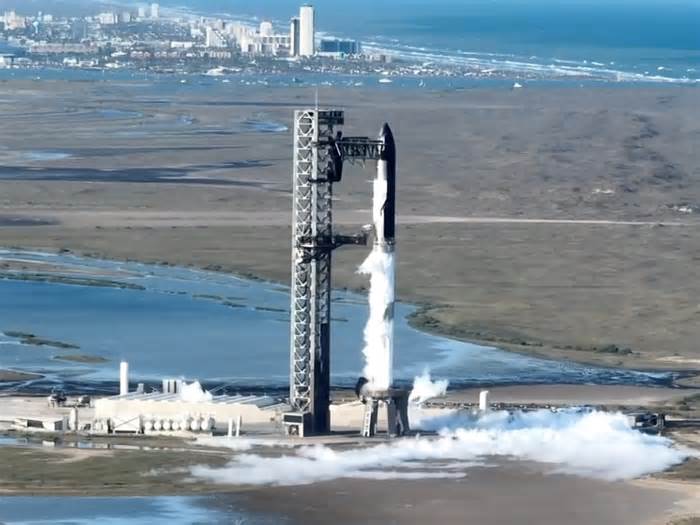
Podcast: Can Anyone Catch SpaceX?
- by Aviation Week
- Nov 01, 2024
- 0 Comments
- 0 Likes Flag 0 Of 5

Your browser does not support iframes, but you can visit
SpaceX’s Starship booster “catch” at the launchpad wowed the space world, but big hurdles remain to launching humans to Mars in 2028.
Don't miss a single episode of the award-winning Check 6. Subscribe in Apple Podcasts, Spotify or wherever you listen to podcasts. Joe Anselmo:
Welcome to this week's Check 6 podcast, where we catch up on SpaceX's flight test of the Starship Super Heavy after its rather spectacular mission and booster recovery on October 13th. Not that anyone will have missed it, but in that flight test, SpaceX launched the Starship, returned and recovered the massive booster by catching it on the launch tower, and flew Starship to a controlled landing in the Indian Ocean. The test was the latest step forward in SpaceX Chief Elon Musk's ambition to cut the cost of launching people and payloads to orbit by 100-fold -- you heard that right, 100-fold -- and launch crews to Mars around 2028.
I'm Joe Anselmo, Aviation Week's Editorial Director and Editor-in-Chief of Aviation Week & Space Technology. And joining me to discuss the milestone and the path ahead for SpaceX, are Space Editor, Irene Klotz, who is based in Cape Canaveral, and Senior Editor, Guy Norris. Both have followed Starliner's progress closely.
Irene, there is so much to discuss here in our limited window. What were your impressions of that flight? I've followed the space industry a long time and I've never seen anything like that catch.
Irene Klotz:
Yes, it was quite remarkable. I think it even surprised SpaceX. They set the goal after Flight 4, Elon Musk did, to try and attempt a catch and had some delays getting things cleared for flight from the FAA. And they launched on the 13th of October. The goals of this flight, in addition to seeing if they could bring the Super Heavy booster back intact on the tower, also wanted to check improvements to the Starship heat shield, which nearly cost the ship on the Flight 4. But it did manage to hang on, if you remember that, that flap hanging during the reentry.
For Flight 5, the ship for the first time did land on target in the ocean, in the Indian Ocean. And then, the catch really kind of turned the corner on this idea of whether SpaceX could accomplish a landing without landing legs, basically to use the tower for both assembly and launch, and also as a way to remove the weight and just ease operability for reuse by having the booster in the tower.
There were a couple things that weren't perfect with it. Right after the flight, the first report was that there were some of the outer engine nozzles of the Super Heavy booster that were warped from the reentry heating, and then also there was a cover, an aero cover, that fell off just before the landing burn. It turned out later that that was actually covering some mission-critical valves for the landing burn. So SpaceX got kind of lucky that the harnesses and the valves remained operational for the landing burn. But all in all, a really impressive feat on fifth flight.
Joe Anselmo:
So Irene, the catch of the booster looked perfect. It was something out of a sci-fi movie I used to watch when I was a kid. But as you just noted, it actually might have been a little bit of a close call. Fill our listeners in.
Irene Klotz:
Well, on October, I think it was the 25th, about a week or so after the flight, Elon Musk posted a short clip on X that actually showed him playing a video game. And in the background, he was getting briefed on the flight from some SpaceX people. They were not identified. And in that, they referred to wanting to tell Elon about "some scary shit" that happened on the flight. And the leadoff on that was the information that there were about a hundred abort scenarios, and one of them nearly triggered the abort of the landing catch. And what would've happened is the Super Heavy would've attempted to crash on the ground near the launch tower. But that didn't trigger. They said they were about a second away from that.
And I think what was interesting about that is that the engineers were saying that they did not really have the time to go through, there were 100 abort scenarios, and they said that they did not have the time to kind of vet them as fully as all the abort scenarios that they vetted for Starship's first flight back in April of '23, which I think they said was the most risky flight. They had to go through the engineering data to mitigate the risk for that flight as much as what they tried to do for this Flight 5. They do have some solutions for that, and it's entirely possible that SpaceX could repeat this flight perhaps with a little bit more margins on all these issues for Flight 6, which they've not yet set a date for. But they do have FAA approval for that flight, provided they stick with a similar trajectory and flight plan as what they proposed for Flight 5.
Joe Anselmo:
Guy Norris, you just heard what Irene said. Isn't that part of the secret of SpaceX's success? They fly by the seat to their pants, they have a high tolerance for risk, a tolerance for failure. I can't imagine a NASA program doing something like this.
Guy Norris:
You're absolutely right, Joe. That's astonishing, what Irene just described is like a classic SpaceX scenario that we've sort of become increasingly used to. And they've really rewritten the real book on how to do space flight, space flight experimentation, and this sort of perpetual cycle really of test, fly fast, test, see what breaks, and test again.
And in fact, really that takes us to where we're going to go next with this mission. Because obviously, the key things that really SpaceX has to demonstrate is the ability to relight the Raptor engine, which is one of the building blocks of this whole program, this huge new engine. They have to show the ability to relight it in the vacuum in space. Remember, the Raptor itself is this full-flow staged combustion engine, which is sort of an amazing fuel cycle in itself. It's never been flown before. So even the fact that it's flown now on these five test missions is again pioneering.
But what has to be proven is the ability to shut it off and restart it in space. This is the next milestone that they'll need, because obviously you have to do the relight so that it can reenter. The reentry capability of the second stage obviously a vital, depend on this capability.
Now, the reason they haven't done it so far, well they hoped to do it on one or more of the earlier flights potentially in March, the third test flight that they did. But control of the vehicle was lost on that, and I think Irene remembers that pretty well. And on the last two, it doesn't seem that they've really attempted to go anywhere near that test because they were really focusing on getting the reentry capabilities tested, which they of course made a home run with that on this, one of course of the second stage, as we saw from video out in the Indian Ocean where the buoy was attached to the camera. And it looked like they nailed it pretty well.
So really, it's the fact that the FAA has been very stringent on kind of its requirements for a controlled reentry, and of course the precise deorbit burn is what they need. But sort of one of the aspects is to bring back the Starship, they would need to come back to Texas if that's where they wanted to try and attempt the landing. They'd have to come in over Mexico and part of Texas, of course. So that's the reason they have to be completely assured that the Raptor is going to work.
Joe Anselmo:
And Elon Musk, his end goal has always been getting to Mars, getting people to Mars. There's two upcoming launch windows for potential Mars missions. The first in 2026, they're going to send an uncrewed vehicle. And then, the goal would be if they can succeed there to actually send humans to Mars in 2028. How likely do you think that is, Guy, that they can meet that target? It's pretty ambitious.
Guy Norris:
It's hugely ambitious. But you can never say no, can you, with SpaceX? They've proved that the doubt is wrong so many times. But okay, let's go through a quick lineup of what we need to happen. Beyond the in-space relight of the Raptor, we need to see the Starship obviously land. So as we just mentioned, that's dependent on the Raptor relight, but also finding a place to land. Maybe Irene can talk about that as well in a minute.
But one of the possibilities is that this time round, SpaceX has outlined a plan to build four of these giant towers, two near where Irene lives and two in Texas. And at the moment, if you want to re-land the Starship as they want to do it, they're going to have to use one of those towers. So one of the potential scenarios is they're looking at putting legs on the Starship. One version is going to have to have legs eventually anyway, and land it somewhere else, potentially in the Pacific, going back to the early days of SpaceX and out in the Johnston Atoll area, or even somewhere like Australia has been mentioned as a potential. So that's the first thing that's got to happen.
Then they've got to do a re-flight of the Super Heavy first stage. That's going to be something which is the next big milestone beyond that. Then begins this long series of big proving flights going out into deep space, beginning with this sort of a long duration test flight, which is a milestone that NASA really requires for the human landing system, human launch system I should say. That needs to show that a Starship can fly around the moon or in the cislunar environment for months at a time to show that it can autonomously operate in the cislunar area just in case there's a delay in getting the crew up from Earth for any manner of reasons. Starship's still got to be a viable vehicle when they get to the moon.
Then beyond that, there's the uncrewed lunar landing. Then if that goes well, then there's a crewed landing. So finally, you're looking at probably 2028 by the time, if all goes well, that that's possible. And it's only then that obviously you can begin thinking about Mars, so 2030, 2031 potentially. I don't know, Irene, what do you think?
Irene Klotz:
That was a great list. One more big technical milestone that's to be demonstrated and developed is propellant transfer in orbit.
Guy Norris:
Please first to comment
Related Post
Stay Connected
Tweets by elonmuskTo get the latest tweets please make sure you are logged in on X on this browser.
Sponsored
Popular Post
Tesla: Buy This Dip, Energy Growth And Margin Recovery Are Vastly Underappreciated
28 ViewsJul 29 ,2024






 Energy
Energy



















